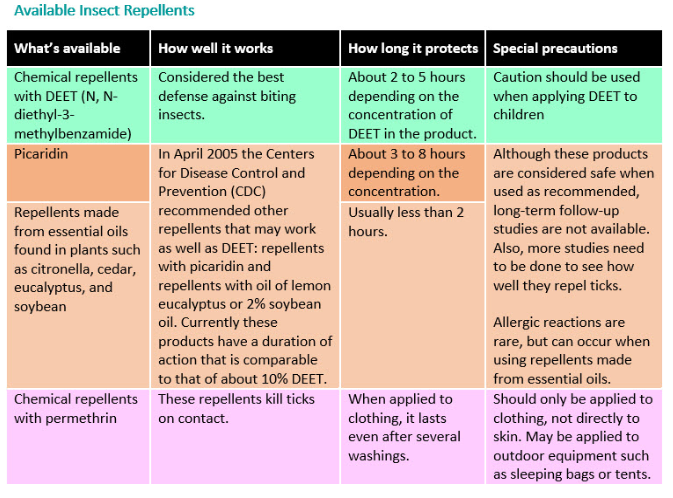Insect Repellent Guide 2019
Nothing looks prettier than legs full of mosquito bites by the end of the summer, but choosing the right insect repellent is more important than looks. Protection against mosquitoes and ticks can protect against more severe illness like Lyme Disease and Zika Virus. For me, choosing an insect repellent can be even more confusing than choosing sunscreen. Because insect repellents have a reputation for higher toxicity than sunscreens, I personally have more hesitation when selecting one. Hopefully, this article will help you confidently pick the insect repellent to best suit your needs.
Because needs can vary so much, I am not making any overall recommendations on specific products in this post. Instead, I am providing an updated list of resources to help us all make confident and educated choices for protection.
Using the EPA Resource, you can go through the following steps to help choose a product that is best for your needs.
The overall biggest questions to consider are:
1 – What you are trying to avoid? – Mosquitos, ticks, or both
2- How long do you need the protection to last?
3- Are you applying on a child or adult?
The two most common ingredients used in most insect repellents are DEET and Picaridin.
As a mom, I am always concerned about not harming my kids while trying to protect them. Here are the three most essential warnings I have found for children.
- According to the American Academy of Pediatrics (AAP), DEET should not be used on children under two months and should not be used in concentrations greater than 30%. However, the EPA says that there is no age restriction for DEET.
- Also, from the AAP “Do not use products that combine DEET with sunscreen. The DEET may make the sun protection factor (SPF) less effective. These products can also overexpose your child to DEET because the sunscreen needs to be reapplied often.”
The CDC states, “ Do not use products containing oil of lemon eucalyptus (OLE) or para-menthane-diol (PMD) on children under three years old.”
Do not apply to children’s hands who frequently put their hands in their mouths.

Addressing use for pregnant and lactating women, the CDC states that, “When used as directed, EPA-registered insect repellents are proven safe and effective, even for pregnant and breastfeeding women.” EPA registered insect repellents include… DEET, Picaridin (known as KBR 3023 and picaridin outside the US), IR3535, Oil of lemon eucalyptus (OLE) or para-menthane-diol (PMD) and 2-undecanone.
When looking at insect repellent ingredients, they are either considered REGISTERED or NON-REGISTERED. Check out the definition of those terms from epa.gov.
REGISTERED – “Before they can be marketed, most skin-applied repellents must be registered by EPA. EPA registration of skin-applied repellent products indicates that they have been evaluated and approved for human safety and effectiveness when applied according to instructions on the label. Our evaluation includes assuring that the product does not pose risks to vulnerable populations, including children and pregnant women.
UNREGISTERED – “Some insect repellent products for sale in the United States do not currently require EPA registration. In the 1990s, EPA evaluated the active ingredients in these unregistered products for safety. We determined that the active ingredients posed minimal risk to human health in the percentages found in products on the market. Based on this minimal risk determination, we decided that products made from these ingredients should be exempt from registration. Note that products made from these ingredients have not been evaluated for effectiveness.
Examples of ingredients used in unregistered repellents are Citronella oil, Cedar oil, Geranium oil, Peppermint oil, Soybean oil.
To learn more about the individual REGISTERED ingredients, click here.
If you want to avoid applying insect repellent to the skin, consider wearing long sleeves and pants and permethrin-impregnated fabrics.
I hope this helps as you venture out and explore this summer and fall!
If you know someone who may find this article helpful, please share it with them! Follow us on social media this week, and subscribe to our growing YouTube channel!
If you would like to receive these posts in your email inbox, Subscribe to our Site.
|